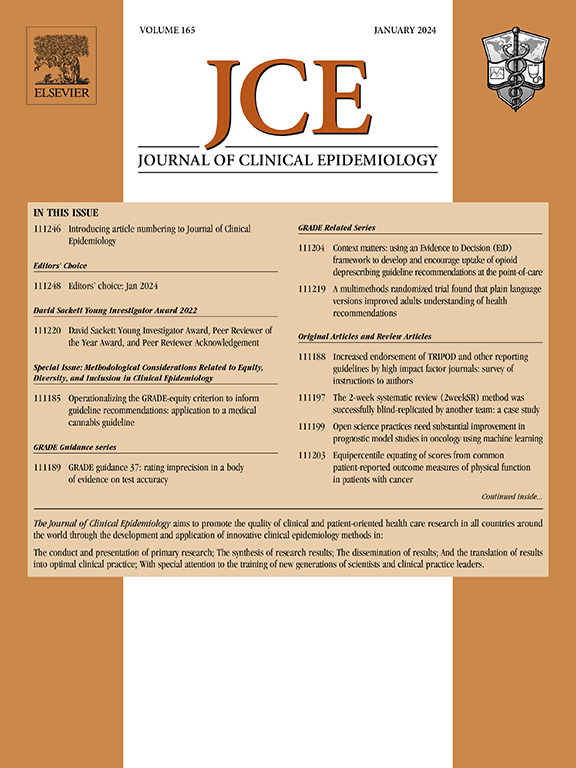低收入和中等收入国家的指南制定者希望制定和使用生活指南,但目前受到重要障碍的限制:一项定性研究的结果。
IF 7.3
2区 医学
Q1 HEALTH CARE SCIENCES & SERVICES
引用次数: 0
摘要
目的:循证临床指南具有改善卫生保健和健康结果的潜力。生活指南方法提供了一种确保指南始终是最新的方法,最大限度地发挥其潜力。然而,迄今为止,大多数关于生活准则的工作都是在高收入国家进行的。本研究的目的是探讨低收入和中等收入国家(LMICs)循证指南制定者制定、适应和使用生活指南的障碍和促进因素。研究设计和环境:我们采用描述性定性研究设计。我们采用目的抽样和滚雪球抽样技术,从中低收入国家和世界卫生组织办公室招募指南开发者参加在线半结构化访谈。使用NVivo 20软件使用专题方法分析数据。蒙纳士大学伦理批准。结果:我们采访了来自中低收入国家(哥伦比亚、印度、伊朗、印度尼西亚、阿根廷和马来西亚)和世卫组织办事处(包括总部、区域办事处和国家办事处)的18名参与者。出现了两个主要主题,以及六个相关的副主题。主要主题是:(1)中低收入国家的人民需要生活指南;(2)资源限制及其对中低收入国家生活指南的影响。结论:我们的研究发现,中低收入国家的指南制定者有开发和使用生活指南的强烈愿望,但目前受到重要障碍的限制。支持中低收入国家制定、适应和使用生活指南的倡议可能有助于克服障碍,满足中低收入国家对生活指南的需求。此外,还必须制定策略,克服开发、调整和实施生活指南方面的已知障碍,如缺乏资源、更新延迟和可及性有限。本文章由计算机程序翻译,如有差异,请以英文原文为准。
Guideline developers in low- and middle-income countries want to develop and use living guidelines, but are currently limited by important barriers: findings from a qualitative study
Objectives
Evidence-based clinical guidelines have the potential to improve health care and health outcomes. Living guidelines methods provide an approach to ensuring guidelines are always up-to-date, maximizing this potential. However, to date, most work on living guidelines has been conducted in high income countries. The objective of this study is to explore the barriers and facilitators to the development, adaptation, and use of living guidelines among evidence-based guideline developers in low- and middle-income countries (LMICs).
Study Design and Setting
We used a descriptive qualitative study design. We employed purposive and snowball sampling techniques to recruit guideline developers from LMICs and World Health Organization offices to participate in online, semistructured interviews. Data were analysed using a thematic approach with NVivo 20 software. Ethics approval was granted by Monash University.
Results
We interviewed 18 participants from LMICs (Colombia, India, Iran, Indonesia, Argentina, and Malaysia) and WHO offices (including headquarters, regional offices, and country offices). Two main themes emerged, along with six associated subthemes. The main themes were as follows: (1) People in LMICs want living guidelines and (2) Resource limitations and their implications for living guidelines in LMICs.
Conclusion
Our research identified that guideline developers in LMICs have a strong desire to both develop and use living guidelines, but are currently limited by important barriers. Initiatives to support development, adaptation, and use of living guidelines in LMICs may help overcome barriers and meet the need for living guidelines in LMICs. It is also essential to design strategies that overcome identified barriers to developing, adapting, and implementing living guidelines, such as a lack of resources, delays in updates, and limited accessibility.
Plain Language Summary
This study looked at how living (continuously updated) approaches can be used to develop, adapt, and use clinical guidelines in settings with limited resources, and explored the pros and cons of each. The findings revealed a strong need to develop and use living guidelines in low-resource settings despite challenges, such as resource scarcity, delays in updating, and limited access to these guidelines. Overall, the findings revealed that living guidelines were worthwhile in LMICs despite all of the related challenges.
求助全文
通过发布文献求助,成功后即可免费获取论文全文。
去求助
来源期刊

Journal of Clinical Epidemiology
医学-公共卫生、环境卫生与职业卫生
CiteScore
12.00
自引率
6.90%
发文量
320
审稿时长
44 days
期刊介绍:
The Journal of Clinical Epidemiology strives to enhance the quality of clinical and patient-oriented healthcare research by advancing and applying innovative methods in conducting, presenting, synthesizing, disseminating, and translating research results into optimal clinical practice. Special emphasis is placed on training new generations of scientists and clinical practice leaders.
 求助内容:
求助内容: 应助结果提醒方式:
应助结果提醒方式:


